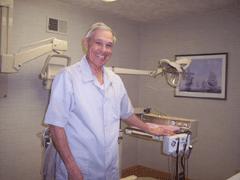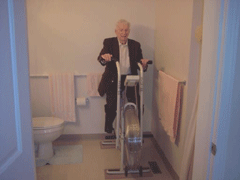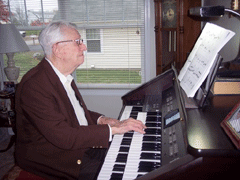Have a Heart
Air Date: Week of July 4, 2008

Dr. Anghinetti (Photo: Bruce Gellerman)
For 60 years, the residents of Framingham, Massachusetts have been poked and prodded, examined and investigated to help reveal the mysteries of heart disease, the nation's number one cause of death. Host Bruce Gellerman visited Framingham to speak with some of the participants of one of the largest and most important epidemiological studies in history.
Transcript
GELLERMAN: It’s Living on Earth, I’m Bruce Gellerman.
[MUSIC: Benny Goodman “We’ll Meet Again” from ‘Sentimental Journey: Hits from the Second World War’ (Legacy—2007)]
In 1945 more Americans died of heart disease than all the U.S. soldiers killed in action during World War II. Cardiovascular disease has been an epidemic since 1921, when it became the leading cause of death in the United States. Cardiologist Dr. Daniel Levy:
LEVY: Remarkably very little was known about its underlying causes. Even less was known about its treatment, and absolutely nothing was known about approaches to its prevention. Really, the wake-up call was when President Roosevelt died in 1945 from untreated, uncontrolled hypertension.
OLD NEWS BROADCAST: We interrupt this program to bring you a special news bulletin from CBS World News. A press association has just announced that President Roosevelt is dead. The president died of a cerebral hemorrhage. All we know so far is that the president died at Warm Springs in Georgia.
LEVY: Shortly before he died, when he was in Yalta in February of 1945 carving up the map of the free world, his blood pressure was running about 250 over 150—numbers that many physicians in training today never see.
GELLERMAN: That’s because today physicians know a lot more about the causes and prevention of cardiovascular disease, thanks in large measure to the small town of Framingham, Massachusetts, 20 miles west of Boston. Residents of Framingham had participated in a study of tuberculosis during World War I. So in 1948, when federally funded Harvard University researchers went looking for a convenient place to study heart disease, they chose Framingham. Five thousand two hundred and nine adults volunteered to undergo medical exams every other year. Now the Framingham Heart Study is commemorating its 60th anniversary. It’s one of the largest, longest-running, and most important observational medical studies in the world.
Dr. Daniel Levy is director of the study and author of the book, “A Change of Heart: How the people of Framingham, Massachusetts helped unravel the mysteries of heart disease.”
LEVY: One of the reasons Framingham was so good for this study was because it was so ordinary. There was nothing exceptional about it. It was average people, a little cross section of America, albeit of white America. But, Framingham was not an unusual town. We very much lucked out. Society has lucked out that there’s a community like this willing to be questioned, poked and prodded have blood taken from you and get nothing in financial return whatsoever.
[SOUND OF DRILLING]
GELLERMAN: Framingham dentist David Anghinetti is one of those who study researchers have poked and prodded.

Dr. Anghinetti (Photo: Bruce Gellerman)
GELLERMAN: The Framingham Heart Study was supposed to last 20 years, but in 1968 researchers decided to continue and expand the study to include the children of the original volunteers. And years later their children were also included. In all, nearly 16,000 residents of Framingham—three generations. Dentist David Anghinetti:
ANGHINETTI: Both of my parents were original participants. My mother had just some mild hypertension but she lived to 98 and a half. My father will be 102 and he doesn’t have any heart disease. When they got the additional funding to carry on the study, they then wanted to get the children involved and as soon as I got notified, I became a participant. My son has gone. My daughter has not been called but hasn’t gone yet. And I’m hoping that my daughter will take advantage of it. And, you talk to any participant, they’ll all tell you the same story: there’s a relationship that—and a bond and a trust and an admiration that the participants have for the researchers and the researchers have for the participants.
[CYCLING SOUNDS]
SULLIVAN: They like you to have you get your heart rate up to—maybe in my case—maybe a hundred.
GELLERMAN: Walter Sullivan is also a participant. He hops on the stationary bicycle he keeps parked in the bathroom of his home at a senior community in Framingham.
SULLIVAN: It’s good to get the heartbeat to be increased for some reason.

The Framingham heart study findings have spurred Walter Sullivan to keep up the healthy exercise.(Photo: Bruce Gellerman)
SULLIVAN: So if I have a salad it goes crunch, crunch, crunch. So I take the damn things out.
GELLERMAN: Walter Sullivan’s wife Katy was also an original heart study participant. She was 87 when she died in 1999, a victim of the silent killer that strikes half a million Americans a year.
SULLIVAN: She had a stroke, so she never recovered consciousness and she died the next morning. She had no history of that.
GELLERMAN: The Framingham researchers only collect data. If they find something medically wrong with a volunteer they don’t treat them, but send the test results to their personal physicians. When the study began in 1948 few people had health insurance so volunteering was one way to get regular medical exams.
SULLIVAN: This will be my 30th next year, every two years for 60 years. I look forward to it.
GELLERMAN: Your participation in this study, it seems to me may have contributed to extending the lives of countless numbers of people.
SULLIVAN: Well I’m so happy with the reaction of the people of Framingham. They were doing something with their fellow citizens that was helpful to society. So, it’s a good feeling, especially for a kid who grew up in Framingham.
GELLERMAN: Walter Sullivan’s three children and now seven of his grandchildren also participate in the heart study. Again, director Daniel Levy:
LEVY: When we recruited our third generation of participants, literally there was hardly a day that went by when one of these 3rd generation individuals did not come in and say, ‘I have waited all my life for this day to come.’ And every time I heard someone say that, it gave me goose bumps.

93 year-old Walter Sullivan has been a heart study participant from the beginning. (Photo: Bruce Gellerman)
The Framingham Heart Study has produced over 15 hundred articles in leading medical journals, and it’s mission has again been expanded. Researchers are now mining their data to discover the genetic basis of not just heart disease and stroke, but cancer, arthritis, diabetes and dementia. It could lead to new ways to diagnose and treat these illnesses. But Dr. Levy is cautious about over-emphasizing the genetic links to disease:
LEVY: I like to tell people; ‘Even if you chose your parents unwisely, there’s still a lot you can do to modify your destiny.’ In other words it’s in our hands. Yes, having family members with premature disease can roughly double your risk of developing a heart attack compared to someone with no family history, but much of that is mediated through things we can control. So even if you do have a bad family history by keeping your cholesterol level very low, your blood pressure low, by not smoking, by being physically active, we would eradicate about 90 or 95 percent of heart disease.
[STUDY PARTICIPANT WALTER SULLIVAN PLAYS “STARDUST” ON ORGAN]
SULLIVAN: I fiddle with it, and I have books with all of the songs that I try to get to fiddle and play every once in a while.
GELLERMAN: Ninety four-year old heart study volunteer Walter Sullivan follows the life sustaining advice, and then some. A few years ago he answered a newspaper ad placed by a local music company.
SULLIVAN: They formed a group of older people. And they offered to give them lessons for the rest of their lives if they bought an organ (laughs).
GELLERMAN: You’re getting your money’s worth, aren’t you?
SULLIVAN: But my life must have ended two or three years ago because they stopped the lessons, mostly because the participants moved away or died. So I just do it on my own now.
[“STARDUST” FINISHES]
GELLERMAN: Walter Sullivan nearly halfway through his ninth decade and the Framingham Heart Study now in its 7th. Both—still going strong.
SULLIVAN: Not very good, is it?
GELLERMAN: It’s great.
SULLIVAN: But I have fun.
Links
The National Heart Lung and Blood Institute's site dedicated to the Framingham Heart Study
Living on Earth wants to hear from you!
Living on Earth
62 Calef Highway, Suite 212
Lee, NH 03861
Telephone: 617-287-4121
E-mail: comments@loe.org
Newsletter [Click here]
Donate to Living on Earth!
Living on Earth is an independent media program and relies entirely on contributions from listeners and institutions supporting public service. Please donate now to preserve an independent environmental voice.
NewsletterLiving on Earth offers a weekly delivery of the show's rundown to your mailbox. Sign up for our newsletter today!
 Sailors For The Sea: Be the change you want to sea.
Sailors For The Sea: Be the change you want to sea.
 The Grantham Foundation for the Protection of the Environment: Committed to protecting and improving the health of the global environment.
The Grantham Foundation for the Protection of the Environment: Committed to protecting and improving the health of the global environment.
 Contribute to Living on Earth and receive, as our gift to you, an archival print of one of Mark Seth Lender's extraordinary wildlife photographs. Follow the link to see Mark's current collection of photographs.
Contribute to Living on Earth and receive, as our gift to you, an archival print of one of Mark Seth Lender's extraordinary wildlife photographs. Follow the link to see Mark's current collection of photographs.
 Buy a signed copy of Mark Seth Lender's book Smeagull the Seagull & support Living on Earth
Buy a signed copy of Mark Seth Lender's book Smeagull the Seagull & support Living on Earth

